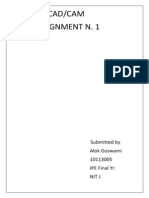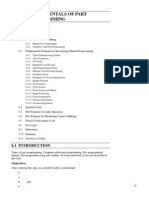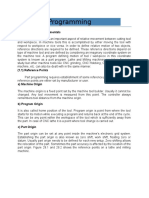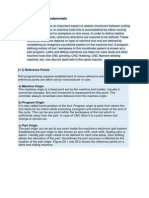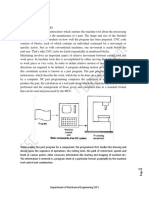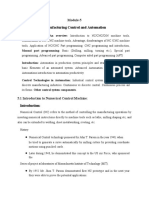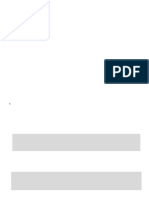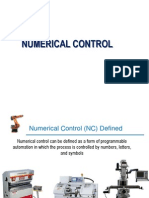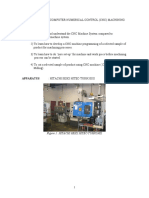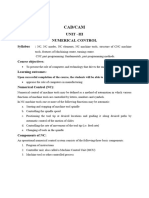Part Programming: Fig. 23.7 Structure of A Block in A Part Program
Uploaded by
blashkogPart Programming: Fig. 23.7 Structure of A Block in A Part Program
Uploaded by
blashkogPart Programming
As mention earlier, a part program is a set of instructions often referred to as blocks, each of which refers to a segment of the machining operation performed by the machine tool. Each block may contain several code words in sequence. These provide: 1. Coordinate values (X, Y, Z, etc.) to specify the desired motion of a tool relative to a work piece. The coordinate values are specified within motion codeword and related interpolation parameters to indicate the type of motion required (e.g. point-to-point, or continuous straight or continuous circular) between the start and end coordinates. The CNC system computes the instantaneous motion command signals from these code words and applies them to drive units of the machine. 2. Machining parameters such as, feed rate, spindle speed, tool number, tool offset compensation parameters etc. 3. Codes for initiating machine tool functions like starting and stopping of the spindle, on/off control of coolant flow and optional stop. In addition to these coded functions, spindle speeds, feeds and the required tool numbers to perform machining in a desired sequence are also given. 4. Program execution control codes, such as block skip or end of block codes, block number etc. 5. Statements for configuring the subsystems on the machine tool such as programming the axes, configuring the data acquisition system etc. A typical block of a Part program is shown below in Fig. 23.7. Note that the block contains a variety of code words such G codes, M codes etc. Each of these code words configure a particular aspect of the machine, to be used during the machining of the particular segment that the block programmes.
Fig. 23.7 Structure of a block in a part program
Appendix-1 provides some details of these codes. A typical sequence of operations in a part program would be, A. Introductory functions such as units, coordinate definitions, coordinate conventions, such as, absolute or relative etc. B. Feeds, speeds, etc. C. Coolants, doors, etc. D. Cutting tool movements and tool changes E. Shutdown
You might also like
- Unit 4 Fundamentals of Part Programming: StructureNo ratings yetUnit 4 Fundamentals of Part Programming: Structure20 pages
- Computer Numerical Control: Part Programming For NC SystemsNo ratings yetComputer Numerical Control: Part Programming For NC Systems30 pages
- Computer Integrated Manufacturing program demonstration & CAMANo ratings yetComputer Integrated Manufacturing program demonstration & CAMA51 pages
- Experiment 8: Title: Manufacturing Lab Computer Numerical Control (CNC) MillingNo ratings yetExperiment 8: Title: Manufacturing Lab Computer Numerical Control (CNC) Milling4 pages
- Unit III CNC Part Programming and Recent Trends (L_250222_145306No ratings yetUnit III CNC Part Programming and Recent Trends (L_250222_1453063 pages
- Structured Text For Simple Programming: FA Integrated Tool PackageNo ratings yetStructured Text For Simple Programming: FA Integrated Tool Package24 pages
- Module - Additive Manufacturing 18 SchemeNo ratings yetModule - Additive Manufacturing 18 Scheme54 pages
- FALLSEM2024-25_BMEE401L_TH_VL2024250103885_2024-07-25_Reference-Material-INo ratings yetFALLSEM2024-25_BMEE401L_TH_VL2024250103885_2024-07-25_Reference-Material-I19 pages
- Title Objective: Figure 1: Hitachi Seiki Hitec-Turn20SiiNo ratings yetTitle Objective: Figure 1: Hitachi Seiki Hitec-Turn20Sii11 pages
- Manufacturing Technology (ME461) Lecture12No ratings yetManufacturing Technology (ME461) Lecture1219 pages
- NC PROGRAMMING AND USE OF CAD-CAM SOFTWARESNo ratings yetNC PROGRAMMING AND USE OF CAD-CAM SOFTWARES24 pages
- Unit 4 & 5 ME8691 Computer Aided Design and ManufacturingNo ratings yetUnit 4 & 5 ME8691 Computer Aided Design and Manufacturing26 pages

